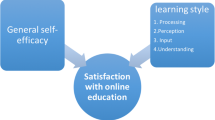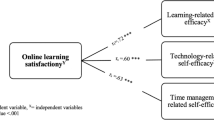Abstract
Dental school graduates operating on patients without having had sufficient practice in school is potentially dangerous to the patients. In order to minimize this danger, it is necessary to establish a virtual learning environment for students. In this study, we incorporated DentSim, a clinical dentistry simulator, into an e-Learning platform. In addition to overcoming the time and space constraints on learning, DentSim can simulate clinical conditions. It also allows students to practice reading case histories and inspecting and diagnosing patients. To construct the research model for this study, we incorporated the four major factors for measuring e-Learner satisfaction—‘learner interface’, ‘learning community’, ‘content’ and ‘personalization’ with the variable of ‘intention to use’. The subjects were 350 dental students studying at the College of Oral Medicine. The structural equation modeling (SEM) results showed that Factors that influenced ‘intention to use’ include ‘learner interface’, ‘learning community’ and ‘personalization’, and ‘intention to use’ affect ‘e-Learner satisfaction’ with the system.





Similar content being viewed by others
References
Kohn, L. T., Corrigan, J. M., and Donaldson, M. S. (Eds.), To err is human: Building a safer health system. National Academy Press, Washington, 2000.
Grottke, O., Ntouba, A., Ullrich, S., Liao, W., Fried, E., Prescher, A., Deserno, T. M., Kuhlen, T., and Rossaint, R., Virtual reality-based simulator for training in regional anaesthesia. Br. J. Anaesth. 103(4):594–600, 2009.
Kahol, K., Vankipuram, M., and Smith, M. L., Cognitive simulators for medical education and training. J. Biomed. Inform. 42(4):593–604, 2009.
Fraser, K., Peets, A., Walker, I., Tworek, J., Paget, M., Wright, B., and McLaughlin, K., The effect of simulator training on clinical skills acquisition, retention and transfer. Med. Educ. 43(8):784–789, 2009.
DeLone, W. H., and McLean, E. R., The DeLone and McLean model of information systems success: A ten-year update. J. Manage Inf. Syst. 19(4):9–30, 2003.
Wang, Y. S., Assessment of learner satisfaction with asynchronous electronic learning systems. Inf. Manage. 41(1):75–86, 2003.
Zhang, D., Zhao, J. L., Zhou, L., and Nunamaker, J. F., Can e-learning replace classroom learning? Commun. ACM 47(5):75–79, 2004.
Chen, C., Chang, R., Hung, M., and Lin, M., Assessing the quality of a web-based learning system for nurses. J. Med. Syst. doi:10.1007/s10916-008-9193-1.
Shachtman, N., E-Learning moves out of the office. <http://www.informationweek.com/809/elearning.htm>.
Alavi, M., Computer-mediated collaborative learning: An empirical evaluation. MIS Quarterly 18(2):150–174, 1994.
Alavi, M., Wheeler, B. C., and Valacich, J. S., Using IT to reengineer business education: An exploratory investigation of collaborative Tele-learning. MIS Quarterly 19(3):293–313, 1995.
Fletcher, G. H., The future of E-learning. T. H. E. J. 32(2):4–5, 2004.
Marki, R. H., Maki, W. S., Patterson, M., and Whittaker, P. D., Evaluation of a web-based introductory psychology course: I. Learning and satisfaction in on-line versus lecture courses. Behav. Res. Meth. Instrum. Comput. 32(2):230–239, 2000.
Tarr, M., Distance learning—bringing out the best in training. Ind. Commer. Train. 30(3):104, 1998.
Thornbory, G., E-learning: The revolution. Occup. Health 55(2):23, 2003.
Nelson, E. A., E-learning: A practical solution for training and tracking in patient-care settings. Nursing Adm. Q. 27(1):29–32, 2003.
Young, K., Using e-learning to liberate the talents of nurses. Ind. Commer. Train. 35(4):137–141, 2003.
Parkinson, C. F., and Parkinson, S. B., A comparative study between interactive television and traditional lecture course offerings for nursing students. Nurs. Health Care 10(9):498–502, 1989.
Daly, J. M., McClelland, E., and Yang, J., The effect of teaching via telecommunications: A comparison of the academic performance of RN-BSN students in satellite centers and on campus. J. Nurs. Educ. 33(4):172–174, 1994.
Shomaker, D., and Fairbanks, J., Evaluation of an RN-to-BSN distance education program via satellite for nurses in rural health care. J. Nurs. Educ. 36(7):328–330, 1997.
Heetebry, I., Hatcher, M., and Tabriziani, H., Web based health education, e-learning, for weight management. J. Med. Syst. 29(6):611–617, 2005.
Lau, F., and Bates, J., A review of e-learning practices for undergraduate medical education. J. Med. Syst. 28(1):71–87, 2004.
Reis, J., McGinty, B., and Jones, S., An e-learning caregiving program for prostate cancer patients and family Members. J. Med. Syst. 27(1):1–12, 2003.
Davis, F. D., Perceived usefulness, perceived ease of use, and user acceptance of information technology. MIS Quarterly 13(3):319–339, 1989.
Davis, F. D., Bagozzi, R. P., and Warshaw, P. R., User acceptance of computer technology: A comparison of two theoretical models. Manag. Sci. 35(8):982–1003, 1989.
Hair, J., Anderson, R., Tatham, R., and Black, W., Multivariate data analysis. Prentice-Hall, Englewood Cliffs, 1998.
Author information
Authors and Affiliations
Corresponding author
Questionnaire for dentistry students
Questionnaire for dentistry students
-
Q1.
The e-learning system is easy to use.
-
Q2.
The user interface of e-learning system gives me the senses of both comfort and usability.
-
Q3.
The user interface of the e-learning system is easy for users to know how it works.
-
Q4.
The operation of the e-learning system is stable.
-
Q5.
The e-learning system makes it easy for you to find the content you need.
-
Q6.
The e-learning system makes it easy for you to discuss questions with other students.
-
Q7.
The e-learning system makes it easy for you to access the shared content from the learning community.
-
Q8.
The e-learning system makes it easy for you to discuss questions with your teachers.
-
Q9.
The e-learning system makes it easy for you to share what you learn with the learning community.
-
Q10.
The e-learning system provides up-to-date content.
-
Q11.
The e-learning system provides content that exactly fits your needs.
-
Q12.
The e-learning system provides sufficient content.
-
Q13.
The content provided by the e-Learning system can help me to achieve the learning objectives.
-
Q14.
The e-learning system enables you to learn the content you need.
-
Q15.
The e-learning system enables you to choose what you want to learn.
-
Q16.
The e-learning system enables you to control your learning progress.
-
Q17.
The e-learning system records your learning progress and performance.
-
Q18.
Even though it is not required, I will continue to use e-Learning system for self-learning.
-
Q19.
I enjoy using the e-learning system to learn.
-
Q20.
I would recommend this e-learning system to other people.
-
Q21.
As a whole, you are satisfied with the e-learning system.
-
Q22.
As a whole, the e-learning system is successful.
Rights and permissions
About this article
Cite this article
Chen, ML., Su, ZY., Wu, TY. et al. Influence of Dentistry Students’ e-Learning Satisfaction: A Questionnaire Survey. J Med Syst 35, 1595–1603 (2011). https://doi.org/10.1007/s10916-010-9435-x
Received:
Accepted:
Published:
Issue Date:
DOI: https://doi.org/10.1007/s10916-010-9435-x




